It’s Magically Delicious Http://cute-overload.tumblr.com Source: Http://imgur.com/r/aww/aPFzTID
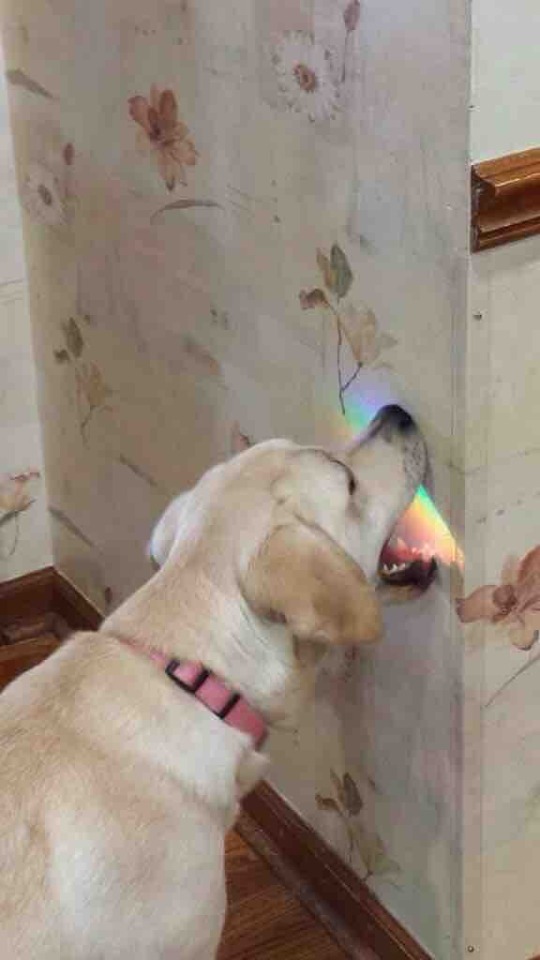
It’s magically delicious http://cute-overload.tumblr.com source: http://imgur.com/r/aww/aPFzTID
More Posts from Smartler and Others
Video: Bat’s tongue baffles researchers
by Hanae Armitage
Most nectar-feeding animals evolve special quirks (mainly of the tongue) that optimize their eating habits.
But for the groove-tongued bat (Lonchophylla robusta), evolution has dealt a bit of a strange hand. Instead of lapping up or siphoning liquid as other mammals do, this bat hovers over its food source and dips its long, slender tongue into the nectar, keeping contact the entire time it drinks.
Researchers filmed the bat with a high-speed video camera to try to decipher the special tongue mechanism, and watched as the fluid flowed upward along the bat’s tongue, against gravity, and into its mouth.
Today, researchers report in Science Advances that the conveyor belt–like mechanism may actually allow these bats to feed more efficiently from certain types of flowers…
(read more: Science/AAAS)
(Credits go to TaySwiftVidz)
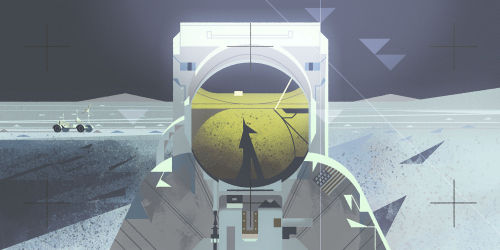



For a moment, that black and white photo should seem like a full color image. (You have to keep both the image and your head very still).
This illusion was used in the new BBC Four series Colour: The Spectrum of Science.
It demonstrates a phenomenon called “cone fatigue.” When we stare at the purple hillside in picture above, photoreceptors in our eyes called cones are stimulated. They send a signal to our brains that says “You’re looking at something purple.” But the sensing ability of those cones decreases the longer we stare at the image - those receptors are, in a way, temporarily used up.
Then when we look at the black and white image, those same cones can’t detect any purple light. Instead they sense the color that remains: green.
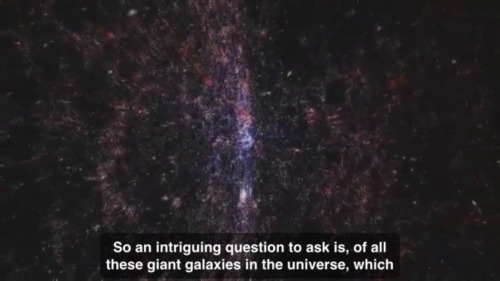
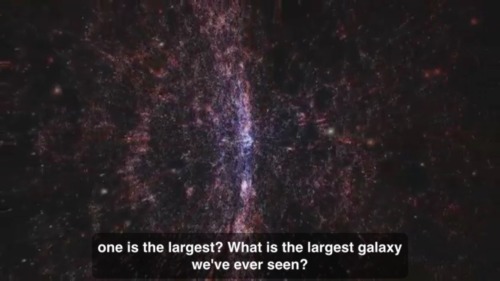
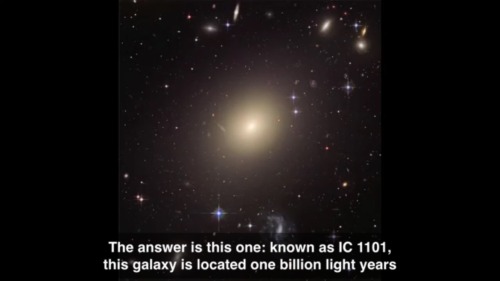
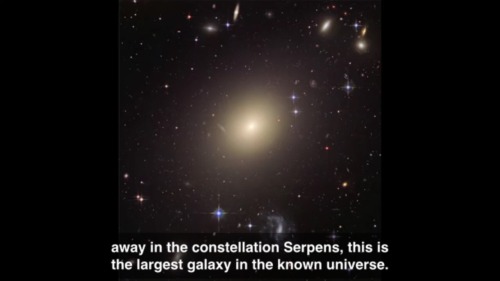
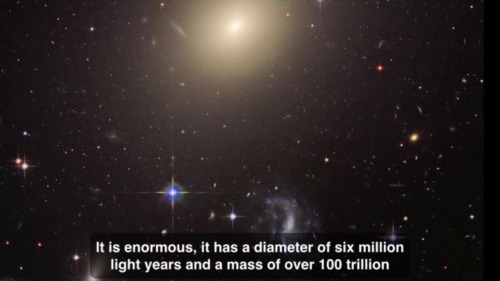
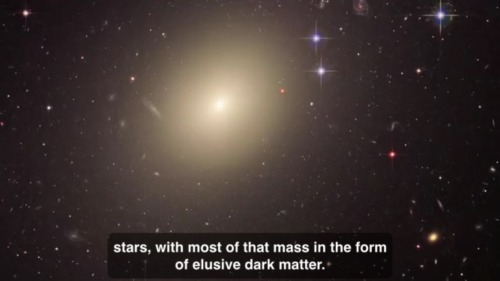
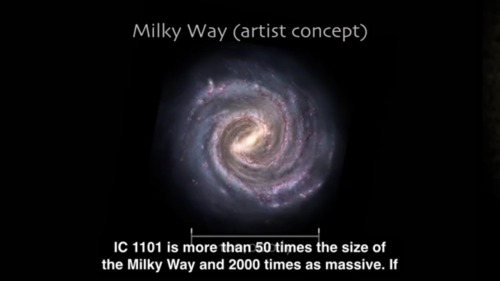
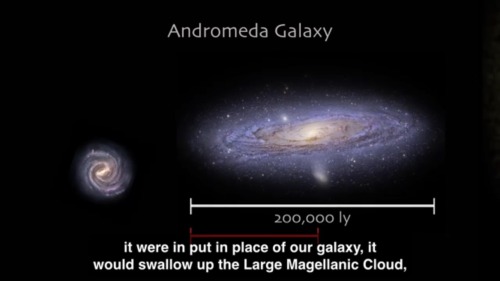
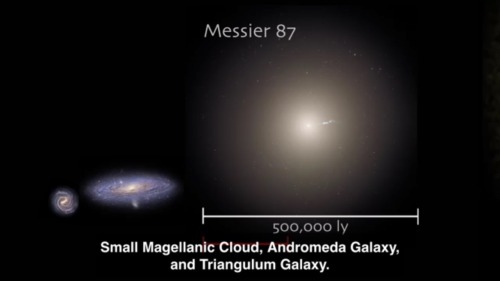
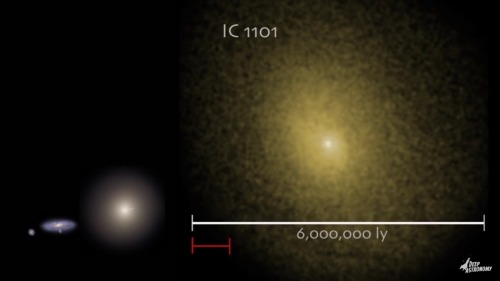
“IC 1101 has spent most of its life colliding with other galaxies and owes its size to these collisions. Over billions of years, galaxies about the size of the Milky Way and Andromeda, have been merging together to sculpt and shape this titan of the cosmos. This galaxy is bereft of star making gases, here rapid star formation has long ago ceased.
IC 1101 is dying a slow death. While not entirely devoid of new stars, unless it continues to merge with newer younger galaxies, IC 1101 will slowly fade to oblivion.”
[[ http://youtu.be/UE8yHySiJ4A ]]
If Earth had Saturn’s Rings
From an excellent post by Jason Davis
From Washington, D.C., the rings would only fill a portion of the sky, but appear striking nonetheless. Here, we see them at sunrise.

From Guatemala, only 14 degrees above the equator, the rings would begin to stretch across the horizon. Their reflected light would make the moon much brighter.

From Earth’s equator, Saturn’s rings would be viewed edge-on, appearing as a thin, bright line bisecting the sky.

At the March and September equinoxes, the Sun would be positioned directly over the rings, casting a dramatic shadow at the equator.

At midnight at the Tropic of Capricorn, which sits at 23 degrees south latitude, the Earth casts a shadow over the middle of the rings, while the outer portions remain lit.

via x

…can you hear me?
There is a nebula near the constellation of Aries ?
there’s a few, you can read a bit about the constellation here ^~^

Street art by SAM3, an artist that paints big as well as small shadows and silhouettes in his urban surroundings.
So cool. The vastness of our solar system put into perspective.
-
 cutelittlefaces reblogged this · 9 years ago
cutelittlefaces reblogged this · 9 years ago -
 shawnadsmith liked this · 9 years ago
shawnadsmith liked this · 9 years ago -
 fae-ble reblogged this · 9 years ago
fae-ble reblogged this · 9 years ago -
 cheechl13 liked this · 9 years ago
cheechl13 liked this · 9 years ago -
 dskenn reblogged this · 9 years ago
dskenn reblogged this · 9 years ago -
 honestlove567-blog liked this · 9 years ago
honestlove567-blog liked this · 9 years ago -
 jensengivesmeheartpains reblogged this · 9 years ago
jensengivesmeheartpains reblogged this · 9 years ago -
 jensengivesmeheartpains liked this · 9 years ago
jensengivesmeheartpains liked this · 9 years ago -
 erinfitzzle reblogged this · 9 years ago
erinfitzzle reblogged this · 9 years ago -
 pinkheadass liked this · 9 years ago
pinkheadass liked this · 9 years ago -
 nosoyfeimusxc reblogged this · 9 years ago
nosoyfeimusxc reblogged this · 9 years ago -
 uwu-not-unu reblogged this · 9 years ago
uwu-not-unu reblogged this · 9 years ago -
 colors-dont-matter liked this · 9 years ago
colors-dont-matter liked this · 9 years ago -
 everartindustries liked this · 9 years ago
everartindustries liked this · 9 years ago -
 hanmrctay reblogged this · 9 years ago
hanmrctay reblogged this · 9 years ago -
 editinggremlin reblogged this · 9 years ago
editinggremlin reblogged this · 9 years ago -
 editinggremlin liked this · 9 years ago
editinggremlin liked this · 9 years ago -
 abovethetrees reblogged this · 9 years ago
abovethetrees reblogged this · 9 years ago -
 abovethetrees liked this · 9 years ago
abovethetrees liked this · 9 years ago -
 antisappointment liked this · 9 years ago
antisappointment liked this · 9 years ago -
 shavedfornothing reblogged this · 9 years ago
shavedfornothing reblogged this · 9 years ago -
 shavedfornothing liked this · 9 years ago
shavedfornothing liked this · 9 years ago -
 the0nlyi liked this · 9 years ago
the0nlyi liked this · 9 years ago -
 tights112de reblogged this · 9 years ago
tights112de reblogged this · 9 years ago -
 catsdancingonthemoon reblogged this · 9 years ago
catsdancingonthemoon reblogged this · 9 years ago -
 delusivewhisper liked this · 9 years ago
delusivewhisper liked this · 9 years ago -
 frostyknickers reblogged this · 9 years ago
frostyknickers reblogged this · 9 years ago -
 ehproudcanadian reblogged this · 9 years ago
ehproudcanadian reblogged this · 9 years ago -
 getiinggravitysalesnet-blog liked this · 9 years ago
getiinggravitysalesnet-blog liked this · 9 years ago -
 ijustbeingme7-blog liked this · 9 years ago
ijustbeingme7-blog liked this · 9 years ago -
 markatch reblogged this · 9 years ago
markatch reblogged this · 9 years ago -
 kittenlover2244-blog liked this · 9 years ago
kittenlover2244-blog liked this · 9 years ago -
 pluutoprojector liked this · 9 years ago
pluutoprojector liked this · 9 years ago -
 bbmino liked this · 9 years ago
bbmino liked this · 9 years ago -
 julieearl liked this · 9 years ago
julieearl liked this · 9 years ago -
 arlillian liked this · 9 years ago
arlillian liked this · 9 years ago -
 altairnoya liked this · 9 years ago
altairnoya liked this · 9 years ago -
 agos5-blog reblogged this · 9 years ago
agos5-blog reblogged this · 9 years ago -
 thunderstormbabe-blog liked this · 9 years ago
thunderstormbabe-blog liked this · 9 years ago -
 pyromaniacgames-blog reblogged this · 9 years ago
pyromaniacgames-blog reblogged this · 9 years ago -
 pyromaniacgames-blog liked this · 9 years ago
pyromaniacgames-blog liked this · 9 years ago -
 kaidelorenzo liked this · 9 years ago
kaidelorenzo liked this · 9 years ago -
 romanthebowman liked this · 9 years ago
romanthebowman liked this · 9 years ago -
 xbasicwentz reblogged this · 9 years ago
xbasicwentz reblogged this · 9 years ago